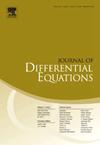Dynamics of classical solutions to a diffusive epidemic model with varying population demographics
IF 2.4
2区 数学
Q1 MATHEMATICS
引用次数: 0
Abstract
We study the asymptotic dynamics of solutions to a diffusive epidemic model with varying population dynamics. The large-time behavior of solutions is completely described in spatially homogeneous environments. When the environment is spatially heterogeneous, it is shown that there exist two critical numbers such that if the ratio of the infected population diffusion rate and the susceptible population rate either exceeds or is less than , then the epidemic model has an endemic equilibrium (EE) solution if and only if the basic reproduction number (BRN) exceeds one. The unique EE is non-degenerate if . Furthermore, results on the global dynamics of solutions are established when . Our results shed some light on the differences on disease predictions for constant total population size models versus varying population size models. Results on the asymptotic profiles of the EEs for small population diffusion rates are also established.
具有不同人口结构的扩散性流行病模型经典解的动态变化
我们研究了具有不同人口动态的扩散性流行病模型解的渐近动态。在空间均质环境中,解的大时间行为被完全描述。当环境在空间上是异质的时,研究表明存在两个临界数 1≤σ⁎≤σ⁎<∞ ,即如果受感染种群扩散速率与易感种群速率之比 dIdS 超过 σ⁎,或小于 σ⁎,那么当且仅当基本繁殖数(BRN)超过 1 时,该流行病模型才有流行均衡(EE)解。如果 dIdS≥σ⁎ ,则唯一的 EE 是非退化的。此外,当 σ⁎=1 时,还建立了关于解的全局动力学的结果。我们的结果揭示了总种群数量恒定模型与种群数量变化模型在疾病预测方面的差异。此外,我们还得出了小种群扩散率 EE 的渐近曲线结果。
本文章由计算机程序翻译,如有差异,请以英文原文为准。
求助全文
约1分钟内获得全文
求助全文
来源期刊
CiteScore
4.40
自引率
8.30%
发文量
543
审稿时长
9 months
期刊介绍:
The Journal of Differential Equations is concerned with the theory and the application of differential equations. The articles published are addressed not only to mathematicians but also to those engineers, physicists, and other scientists for whom differential equations are valuable research tools.
Research Areas Include:
• Mathematical control theory
• Ordinary differential equations
• Partial differential equations
• Stochastic differential equations
• Topological dynamics
• Related topics

 求助内容:
求助内容: 应助结果提醒方式:
应助结果提醒方式:


